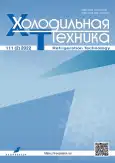Development of an Air Electric Compressor for a No-Bleed Environmental Control System of an Advanced Regional Aircraft
- Authors: Tishchenko I.V.1,2, Chizhikov V.E.1, Tsarkov I.A.3, Likhachev I.V.4, Moroshkin Y.V.4, Ovdienko M.A.5, Merkulov V.I.1,2
-
Affiliations:
- Research and Production Association “Nauka”
- Bauman Moscow State Technical University
- Nauka-Energotech
- State Research Institute of Aviation Systems
- Central Institute of Aviation Motors
- Issue: Vol 111, No 2 (2022)
- Pages: 115-122
- Section: Original Study Articles
- URL: https://freezetech.ru/0023-124X/article/view/110694
- DOI: https://doi.org/10.17816/RF110694
- ID: 110694
Cite item
Abstract
BACKGROUND: Aircraft designers strive to increase the fuel efficiency of aircrafts, including increasing the efficiency of aviation environmental control systems (ECS) by introducing an autonomous source of compressed air with an electric drive as part of aircraft.
AIM: The present paper aimed to consideration of the results of research work (R&D) of the technologies demonstrator for the electric compressor of the aircraft electric ECS and estimation of the performance and compliance of the simulated and experimental characteristics of this electric compressor.
MATERIALS AND METHODS: Comparison of the simulated and experimental characteristics of the electric compressor of the electric ECS of the aircraft was carried out by confirming the compliance of the operating parameters of the technologies demonstrator for the electric compressor with those specified in the request for proposals (RFP), and by comparing the simulated and experimental values of the compression ratio of the compressor stage, isentropic coefficient of performance (COP), obtained during R&D study.
RESULTS: Information about the technical characteristics and design of the electric compressor is given and discussed. A comparative analysis of the presented simulated and experimental characteristics of the electric compressor has been carried out.
CONCLUSIONS: Conclusions are drawn on the compliance of the compressor characteristics with the characteristics specified in the RFP; on the achieved level of readiness of the technology of the electric compressor for the electric ECS of the aircraft, on the need for experimental design work on the electric compressor, taking account of external influencing factors typical for an application as part of aviation equipment.
Full Text
About the authors
Igor V. Tishchenko
Research and Production Association “Nauka”; Bauman Moscow State Technical University
Author for correspondence.
Email: iv.tishenko@npo-nauka.ru
ORCID iD: 0000-0001-6094-8723
SPIN-code: 5630-4301
Cand. Sci. (Tech.)
Russian Federation, Moscow; MoscowVladimir E. Chizhikov
Research and Production Association “Nauka”
Email: ve.chizhikov@npo-nauka.ru
ORCID iD: 0000-0002-2114-2986
SPIN-code: 2325-9450
Russian Federation, Moscow
Igor A. Tsarkov
Nauka-Energotech
Email: ia.tsarkov@evogress.com
ORCID iD: 0000-0002-1188-7466
SPIN-code: 9963-3666
Russian Federation, Moscow
Igor V. Likhachev
State Research Institute of Aviation Systems
Email: ivlihachev@gosniias.ru
ORCID iD: 0000-0003-2813-9138
SPIN-code: 6033-8689
Cand. Sci. (Tech.), Associate Professor
Russian Federation, MoscowYaroslav V. Moroshkin
State Research Institute of Aviation Systems
Email: yvmoroshkin@2100.gosniias.ru
ORCID iD: 0000-0002-6274-3454
SPIN-code: 9593-3384
Cand. Sci. (Tech.)
Russian Federation, MoscowMaxim A. Ovdienko
Central Institute of Aviation Motors
Email: maovdienko@ciam.ru
ORCID iD: 0000-0003-2255-9430
SPIN-code: 2575-3726
Russian Federation, Moscow
Vladislav I. Merkulov
Research and Production Association “Nauka”; Bauman Moscow State Technical University
Email: merkulov@bmstu.ru
ORCID iD: 0000-0002-3455-3709
SPIN-code: 8409-8754
Dr. Sci. (Tech.), Professor
Russian Federation, Moscow; MoscowReferences
- Smagin DI, Starostin KI, Savel’ev RS, et al. Analiz konkuriruyushchikh variantov system konditsionirovaniya vozdukha bez otbora vozdukha ot dvigateley na etape kontseptual’nogo proektirovaniya kompleksa bortovykh system passazhirskogo samoleta. Computational nanotechnology. 2019;6(3):86–91. (In Russ). doi: 10.33693/2313-223X-2019-6-3-86-91
- D’yachenko YuV, Sparin VA, Chichindaev AV. et al. Sistemy zhizneobespecheniya letatel’nykh apparatov. Novosibirsk: Izd-vo NGTU; 2019. (In Russ.).
- Kalliopin AK, Savel’ev RS, Smagin DI. Main trends in designing air conditioning systems for future-technology vehicles. Inzhenerny zhurnal: nauka i innovatsii. 2017;6:1-8. (In Russ). doi: 10.18698/2308-6033-2017-6-1627
- Cronin MJ. Design aspect of systems in all electric aircraft. SAE Technical Papers Series. 1982;91:4:821158–821559:4453–4463.
- Voronovich S, Kargapol’tsev V, Kutakhov V. Polnost’yu elektricheskiy samolet. Aviapanorama. 2009;2:23–27. (In Russ).
- Nelson T. B787 systems and performance. Boeing; 2005.
- Liebherr-Aerospace, 2016. Germany, Liebherr-International Deutschland GmbH. [cited 20.12.2016]. Available from: https://www.liebherr.com/shared/media/aerospace-and-transportation/aerospace/downloads/magazines/aets-magazines-recent/liebherr-aerospace-magazine-2016-en.pdf
- Sypalo KI, Medvedskiy AL, Babichev OV, et al. Engineering of Aircraft Demonstrator. Trudy MAI. 2017;95. [cited 11.08.2022]. Available from: http://mai.ru//upload/iblock/6fa/Sypalo_Medvedskiy_Babichev_Kazarinov_Kan_rus.pdf (In Russ).
- Volokitina EV, Vlasov AI, Kopchak AL et al. Elektroprivod kompressora sistemy konditsionirovaniya vozdukha v kontseptsii polnost’yu elektrifitsirovannogo samoleta. Electronics and electrical equipment of transport. 2011;4:44–49. (In Russ).
- Smagin DI, Starostin KI, Savel’ev RS, et al. Method for determining the design parameters of a centrifugal air compressor based on a mathematical model of a non-selective air conditioning system. Modern science: actual problems of theory & practice. Series: Natural & Technical Sciences. 2020;10:115–121. (In Russ). doi: 10.37882/2223-2966.2020.10.28
Supplementary files













